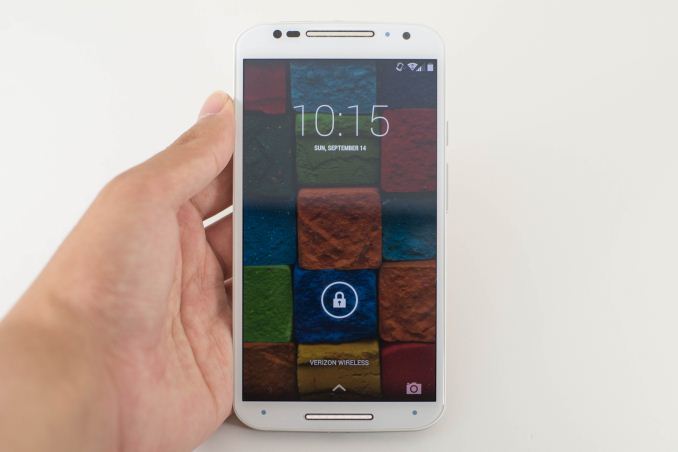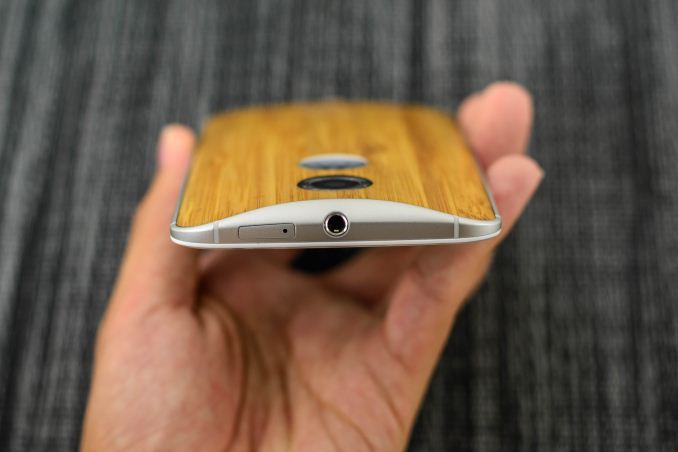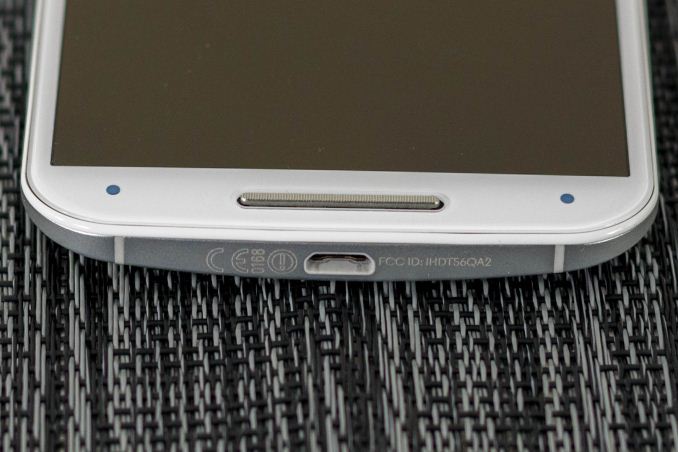The New Motorola Moto X (2nd Gen) Review
by Joshua Ho on September 17, 2014 9:00 AM EST- Posted in
- Smartphones
- Motorola
- Android
- Mobile

Introduction
While I talked about Motorola’s issues in the launch article for the new Moto X, it’s well worth repeating. Motorola has been through a lot these past few years. Once the iconic symbol of Android with their Droid smartphones, Motorola had lost its way. It wasn’t unusual to see one phone launch after the other, with no real regard for strategy, and no real cohesive message to tie all of their devices together. If anything, there was a point where Motorola had become an ODM for network operators in the US, with no real international presence. After Google acquired it in 2012, we saw the launch of the Moto X in 2013. The amount of hype that I saw online before the announcement of the Moto X was unlike anything I’ve ever seen.
Unfortunately, the device that launched didn’t quite fit with the hype. The Snapdragon S4 Pro chipset was decidedly mid-range by the time it launched. The display was good for the time, but AMOLED wasn’t quite the imminent LCD replacement that it is today. The camera was also rather unfortunate at launch. For better or worse, the Moto X was a phone with the right size and shape, but a lot of hardware choices that aged poorly. This leads us to the new Moto X. On the surface, this phone corrects a lot of issues that were present in the original Moto X. The new Moto X brings an SoC that is up to par with its competition, a new camera with a Sony sensor, and an improved AMOLED panel. Of course, I’m not going to spend too much time covering the basic specifications when a table will suffice.
| Motorola Moto X (Gen 1) | Motorola Moto X (Gen 2) | |
| SoC | 1.7 GHz Dual Core Snapdragon S4 Pro | 2.5 GHz Quad Core Snapdragon 801 |
| RAM/NAND | 2 GB, 16/32/64GB NAND | 2GB, 16/32GB NAND |
| Display | 4.7” 720p Super AMOLED | 5.2” 1080p Super AMOLED |
| Network | 2G / 3G / 4G LTE (Qualcomm MDM9x15 IP block UE Category 3 LTE) | 2G / 3G / 4G LTE (Qualcomm MDM9x25 IP block UE Category 4 LTE) |
| Dimensions | 129 x 65.3 x 5.7-10.4mm, 139 grams | 140.8 x 72.4 x 3.8-9.9 mm, 144 grams |
| Camera | 10MP Rear Facing, 1/2.6" CMOS size (OV10820), 2.1MP FFC | 13MP Rear Facing, 1/3.06" CMOS size (Sony IMX135), 2.1MP FFC |
| Battery | 2200 mAh, 3.8V, 8.36 Whr | 2300 mAh, 3.8V, 8.74 Whr |
| OS | Android 4.4.4 | Android 4.4.4 |
| Connectivity | 802.11a/b/g/n/ac + BT 4.0, USB2.0, GPS/GNSS, MHL, DLNA, NFC | 802.11a/b/g/n/ac + BT 4.1, USB2.0, GPS/GNSS, MHL, DLNA, NFC |
| SIM Size | NanoSIM | NanoSIM |
As with most reviews, physical impressions are always a good place to start. In terms of look and feel, the new Moto X starts off incredibly well. The metal frame is something that Motorola is especially proud of, as they've managed to enable an external antenna design without causing some of the infamous deathgrip issues. At any rate, it really feels great in the hand, especially because of the varying thickness. The metal frame can be as thin as 3.3mm in the corners, which really feels razor thin. Fortunately, the center is much thicker to provide for better grip. As a result, the phone is secure in the hand and I never really felt like I would drop it. Overall, I really think the feel of the phone is great. While the size is approaching an uncomfortable level, it manages to stay just short of it because the phone is so thin.
However, I’d like to cut this short as I’ve already given most of my initial impressions in the launch piece. While I haven’t been able to get around to writing my experience with Motorola’s tour, Motorola and their PR team have done an incredible job of introducing the product and allowing for plenty of time to get first impressions, photos, and ask all kinds of questions.
Cellular Architecture
Instead, given the amount of information disclosed by Motorola, I wanted to start this review with a discussion about cellular architecture, as it’s one of the few areas where we still seem to be working with black boxes. For those that are unfamiliar with the basics of how current RF architecture is set up, there are a few major components to talk about. We have antennas, antenna switches and duplexers, band filters, power amplifiers, a transceiver (which is made of multiple parts but that’s for another day), and the modem.
So let’s talk about what’s in the new Moto X. While antennas are still an area I’ve been working on learning more about, we can talk about band support on the Moto X. I’ve attached a table below with a full list of supported bands.
| Motorola Moto X (2014) | ||||||||
| FCC ID | Operator/Region Target | CDMA Bands | GSM | WCDMA | LTE | CA | ||
| IHDT56QA1 (XT1095/XT1097) | AT&T/T-Mobile USA | - | 850, 900, 1800, 1900 | 850, 900, AWS, 1900, 2100 | 2, 3, 4, 5, 7, 17, 29 | - | ||
| IHDT56QA2 (XT1096) | Verizon | 800, 1900 | 850, 900, 1800, 1900 | 850, 900, 1900, 2100 | 2, 3, 4, 7, 13 | - | ||
| IHDT56QA3 (XT1092) | ? | 800, 1900 | 850, 900, 1800, 1900 | 850, 900, AWS, 1900, 2100 | 2, 4, 5, 12, 17, 25, 26, 41 | - | ||
| IHDT56QA4 (XT1093/XT1094) | EU | - | 850, 800, 1800, 1900 | 850, 900, 1800, 1900, 2100 | 1, 3, 7, 8, 20 | - | ||
What might be notable is the lack of carrier aggregation on the new Moto X, which suggests that there is only a WTR1625L transceiver inside, with no WFR1620 companion chip to go with it. This is a rather conventional configuration at this point, and I suspect that phones with support for carrier aggregation will have to wait until WTR3925 which should be in most high end phones in 2015. The modem is also common at this point, as the MDM9x25 IP block in Snapdragon 800/801 has been around since the LG G2 which launched a year ago.
Of course, the real story here is the antenna tuner which I also wrote about in the launch piece. While most of the antenna tuner is hidden from view, there is one aspect that seems to be exposed to the OS. This one aspect is Cypress Semiconductor’s CapSense controller. This sounds strange, but I don’t think there’s any other explanation for why this controller is present. While it’s normally used for capacitive buttons such as in the Samsung Galaxy S/Galaxy Note line, there are no capacitive buttons or sliders present on the phone. In addition, none of the gestures/actions seem to rely upon capacitive sensing. This seems to rely upon the IR sensor system instead, so that doesn’t make sense either. The touchscreen is definitely an Atmel solution. This leaves the antenna tuner. While a bit outlandish, it seems that this controller is capable of detecting capacitance directly in addition to determining whether a finger/hand is on the sensor or not. While I’m sure that it’s necessary for Motorola to measure the standing wave ratio/signal reflection in addition to capacitive sensing on the relevant antenna pieces, this could give Motorola’s antenna tuner an advantage in speed as the capacitive sensors could detect the change in capacitance and pre-emptively change the tuning in the antennas instead of waiting for an increase in signal reflection before attempting to retune the antenna.













179 Comments
View All Comments
cknobman - Wednesday, September 17, 2014 - link
Hmmm.........Crap screen
Crap battery life
Crap camera
Why should anyone buy this again?
piroroadkill - Wednesday, September 17, 2014 - link
They won't.There were reasons to buy Moto X, but this new version is pointless, it's huge and worse than the alternatives.
soccerballtux - Thursday, September 18, 2014 - link
I don't understand what the hate is. I still think it's a great phone.gg555 - Wednesday, September 24, 2014 - link
I'd say it has a very good, but not top of the line screen. A passable camera. And okay battery life (bettery than many of last years phones), but again not top of the line for today's flagships. So your characterizations are unfair, I think.The Moto X does have a beautiful design, arguably one of the best out there, on a Par with the HTC One M8. It also has the active display, always on voice commands, and the hand gestures, which sound like they are very well developed features that add convenience (unlike the gimmicky heartrate crap on other phones).
It has basically stock Android, without a bunch of bloat software, which many people like. And this will also make it easy for it to get very quick updates to new version of the OS (all of Motorola's additions are downloadable as apps and do not require Motorola to spend a lot of time updating its skin, etc., for a new version of Android).
It also as a super sophisticated antenna design, as explained in the AnandTech preview of the phone a couple weeks ago. That ought to make it industry leading, if you know, you use your phone to connect to a network.
And it has a once of a kind four microphone noise cancellation solution. This is extremely unusual. The best noise cancellation chip out their (from Audience) has a three microphone option, but don't know of anyone who has even implemented that (if so it's very rare). Two microphones is the norm. So four microphones is exception. Unfortunately, AnandTech did not test it like they used to do. But it could make for incredible call clarity in noisy settings.
So the Moto X is certainly not necessarily for everyone. There are arguments to be made for other phones. But I think it holds it own, offers useable features, rather than gimmicks, and has a lower price than other flagships. It's a prefectly good choice. Other phones have their own shortcomings.
DeciusStrabo - Wednesday, September 17, 2014 - link
Man, that's sad to see all these regressions. I love my Moto X, could easily deal with the increased size and love to see the performance, but that battery life is simply embarassing. Worse than last years version? That's simply not acceptable. Worse screen in some respects and a camera that's somewhat better, but not really good doesn't help.I really was very close to ordering the new Moto X, but it seems I will have to wait at least until the new Nexus device, maybe even longer. Or - god forbid - think about an iPhone.
semo - Wednesday, September 17, 2014 - link
In this day and age, regression sells! I have no idea how but putting taking useful features away somehow generates more sales. It's also another chance to (re)introduce groundbreaking and amazing features at a later date!I think these days, if you are a phone manufacturer, all you have to do is make the screen bigger and you can take a massive dump on anything else. Better still, if you are a monitor manufacturer, just stick an LTE chip to one of your monitors and sell it as the best phone ever.
MrGutts - Wednesday, September 17, 2014 - link
Not to be a smart ass; well yeah I am going to be.Why in the world does someone want to invest money in a company that gets pass around like some prostitute on Saturday night? Who's turn is it this year, IBM was it?
The company doesn't communicate anything to the consumers, they horribly screwed a ton of customers on new phones telling them they are NOT upgrading the android OS on the phones. The list can go on with them.
DeciusStrabo - Wednesday, September 17, 2014 - link
Which phones don't get an update by Motorola?soccerballtux - Thursday, September 18, 2014 - link
The Atrix4G was marketed as the worlds most powerful phone, and never made it past Gingerbread even with its 1GB RAM and dual core processor.I still hate them for it
randomlinh - Wednesday, September 17, 2014 - link
Hrm, no T-Mobile LTE band 12... which is the newly acquired 700mhz VZW band I believe? Though, almost moot given how disappointing the battery life is.